MITSUBISHI L200 2004 (in English) Workshop Manual
Manufacturer: MITSUBISHI, Model Year: 2004, Model line: L200, Model: MITSUBISHI L200 2004Pages: 264, PDF Size: 4.14 MB
Page 51 of 264
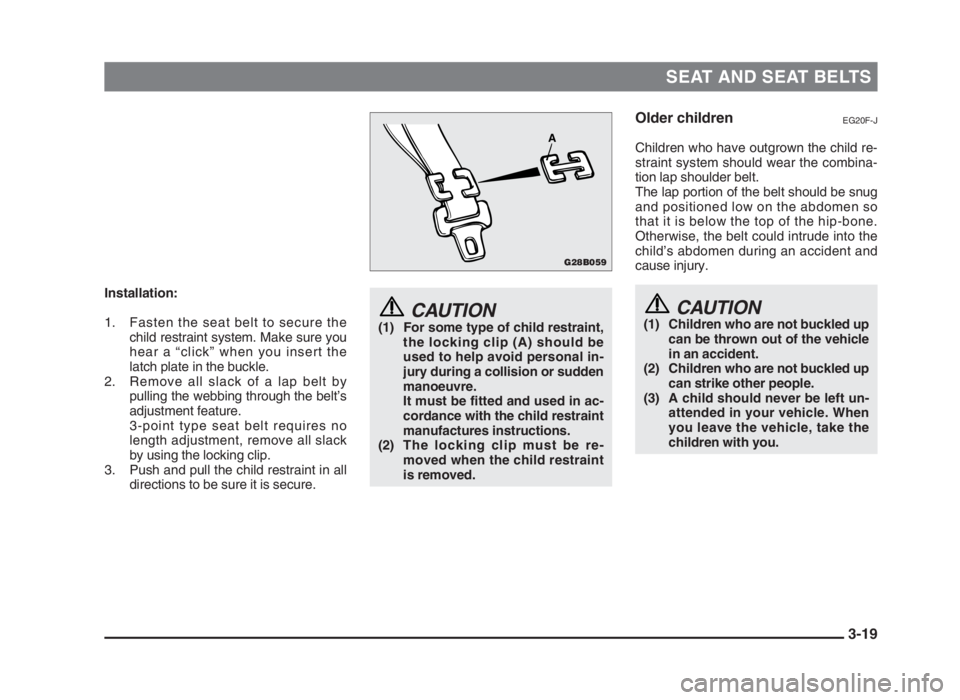
SEAT AND SEAT BELTS
3-19
Installation:
1. Fasten the seat belt to secure the
child restraint system. Make sure you
hear a “click” when you insert the
latch plate in the buckle.
2. Remove all slack of a lap belt by
pulling the webbing through the belt’s
adjustment feature.
3-point type seat belt requires no
length adjustment, remove all slack
by using the locking clip.
3. Push and pull the child restraint in all
directions to be sure it is secure.
Older childrenEG20F-J
Children who have outgrown the child re-
straint system should wear the combina-
tion lap shoulder belt.
The lap portion of the belt should be snug
and positioned low on the abdomen so
that it is below the top of the hip-bone.
Otherwise, the belt could intrude into the
child’s abdomen during an accident and
cause injury.
CAUTION(1) Children who are not buckled up
can be thrown out of the vehicle
in an accident.
(2) Children who are not buckled up
can strike other people.
(3) A child should never be left un-
attended in your vehicle. When
you leave the vehicle, take the
children with you.CAUTION(1) For some type of child restraint,
the locking clip (A) should be
used to help avoid personal in-
jury during a collision or sudden
manoeuvre.
It must be fitted and used in ac-
cordance with the child restraint
manufactures instructions.
(2) The locking clip must be re-
moved when the child restraint
is removed.
G28B059
A
03engL2_240082_4 22-01-2004 13:01 Page 3-19
Page 52 of 264
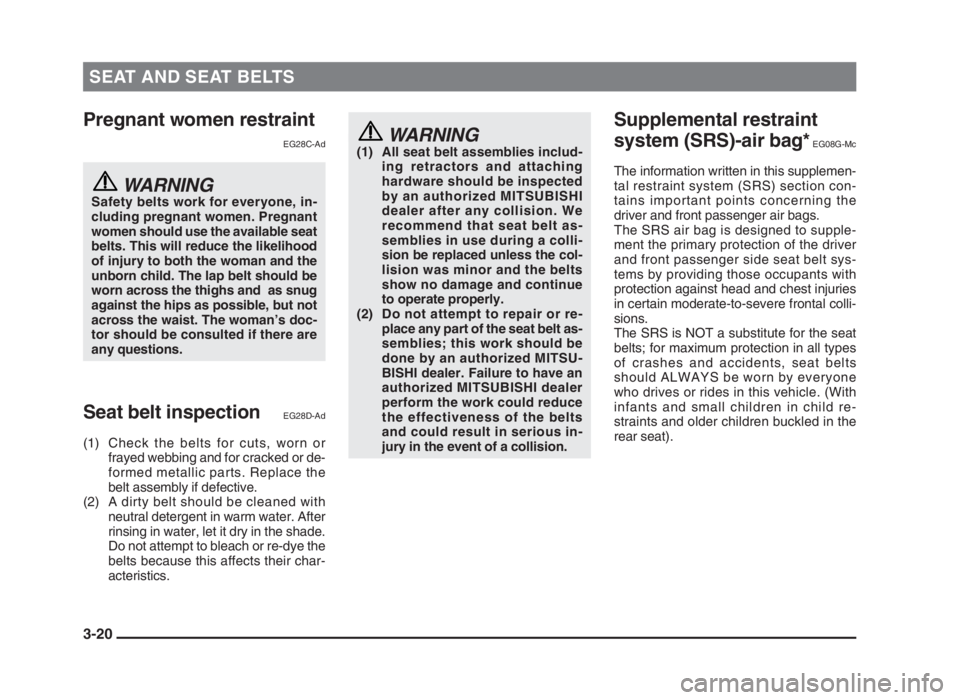
SEAT AND SEAT BELTS
3-20
Pregnant women restraint
EG28C-Ad
WARNINGSafety belts work for everyone, in-
cluding pregnant women. Pregnant
women should use the available seat
belts. This will reduce the likelihood
of injury to both the woman and the
unborn child. The lap belt should be
worn across the thighs and as snug
against the hips as possible, but not
across the waist. The woman’s doc-
tor should be consulted if there are
any questions.
Seat belt inspectionEG28D-Ad
(1) Check the belts for cuts, worn or
frayed webbing and for cracked or de-
formed metallic parts. Replace the
belt assembly if defective.
(2) A dirty belt should be cleaned with
neutral detergent in warm water. After
rinsing in water, let it dry in the shade.
Do not attempt to bleach or re-dye the
belts because this affects their char-
acteristics.
WARNING(1) All seat belt assemblies includ-
ing retractors and attaching
hardware should be inspected
by an authorized MITSUBISHI
dealer after any collision. We
recommend that seat belt as-
semblies in use during a colli-
sion be replaced unless the col-
lision was minor and the belts
show no damage and continue
to operate properly.
(2) Do not attempt to repair or re-
place any part of the seat belt as-
semblies; this work should be
done by an authorized MITSU-
BISHI dealer. Failure to have an
authorized MITSUBISHI dealer
perform the work could reduce
the effectiveness of the belts
and could result in serious in-
jury in the event of a collision.
Supplemental restraint
system (SRS)-air bag*
EG08G-Mc
The information written in this supplemen-
tal restraint system (SRS) section con-
tains important points concerning the
driver and front passenger air bags.
The SRS air bag is designed to supple-
ment the primary protection of the driver
and front passenger side seat belt sys-
tems by providing those occupants with
protection against head and chest injuries
in certain moderate-to-severe frontal colli-
sions.
The SRS is NOT a substitute for the seat
belts; for maximum protection in all types
of crashes and accidents, seat belts
should ALWAYS be worn by everyone
who drives or rides in this vehicle. (With
infants and small children in child re-
straints and older children buckled in the
rear seat).
03engL2_240082_4 22-01-2004 13:01 Page 3-20
Page 53 of 264

SEAT AND SEAT BELTS
3-21
WARNINGIT IS VERY IMPORTANT TO ALWAYS
PROPERLY WEAR YOUR SEAT
BELT, EVEN WITH AN AIR BAG.
(1)
Seat belts help keep the driver
and front passenger properly po-
sitioned, which reduces injury
risk in all collisions, and reduces
the risk of serious or fatal injuries
when the air bags inflate.
During sudden braking just be-
fore a collision, an unrestrained
or improperly restrained driver
or front passenger can move
forward into direct contact with
or within close proximity to the
air bag which may then deploy
during the collision.
The initial stage of air bag infla-
tion is the most forceful which
could cause serious or fatal in-
juries if the occupant contacts it
at this stage.
(2) Seat belts reduce the risk of in-
jury in roll-overs, side or rear im-
pact collisions, and in lower-
speed frontal collisions, be-
cause driver’s and passenger’s
air bags are not designed to in-
flate in those situations.
(3) Seat belts reduce the risk of be-
ing thrown from your vehicle in
a collision or roll-over.
(5) Do not sit on the edge of the
seat, or lean head or chest close
to the steering wheel or instru-
ment panel. Do not put feet or
legs on or against the instru-
ment panel.
(6) Place all infants and small chil-
dren in the rear seat and prop-
erly restrained using an appro-
priate child restraint system.
The rear seat is the safest for in-
fants and children.
WARNINGIT IS VERY IMPORTANT TO BE
PROPERLY SEATED.
A driver or front passenger too close
to the steering wheel or instrument
panel during air bag deployment can
be killed or seriously injured.
Air bags inflate very fast, and with
great force.
If the driver and front passenger are
not properly seated and restrained,
the air bags may not protect you
properly, and could cause serious or
fatal injuries when it inflates.
(1) Before driving, adjust the dri-
ver’s seat as far back as possi-
ble while still maintaining com-
plete control of the vehicle.
(2) Before driving, adjust the front
passenger seat as far back as
possible.
(3) Make sure all vehicle occupants
are always properly restrained
using the available seat belts.
(4) With seat belts properly fas-
tened, the driver and front pas-
senger should sit well back and
upright without leaning against
the window or door.
G28G157
03engL2_240082_4 22-01-2004 13:01 Page 3-21
Page 54 of 264

SEAT AND SEAT BELTS
3-22
(7) Infants and small children
should never be unrestrained,
stand up against the instrument
panel or held in your arms or on
your lap. They could be seri-
ously injured or killed in a colli-
sion, including when the air bag
inflates. They should be prop-
erly seated in the rear seat in an
appropriate child restraint sys-
tem. See the “Child restraint”
section of this owner’s manual.• REAR-FACING CHILD RESTRAINTS
must NOT be used in the front pas-
senger seat as it places an infant
too close to the passenger air bag.
The force of an inflating air bag
could kill or cause serious injuries
to the child.• FRONT-FACING CHILD RESTRAINTS
should not be used in the front pas-
senger seat whenever possible; if
they must be used in the front pas-
senger seat, adjust the seat to the
fully backward position. Failure to
do so could kill or cause serious in-
juries to the child.
G28G176G28G436G28G439
03engL2_240082_4 22-01-2004 13:01 Page 3-22
Page 55 of 264
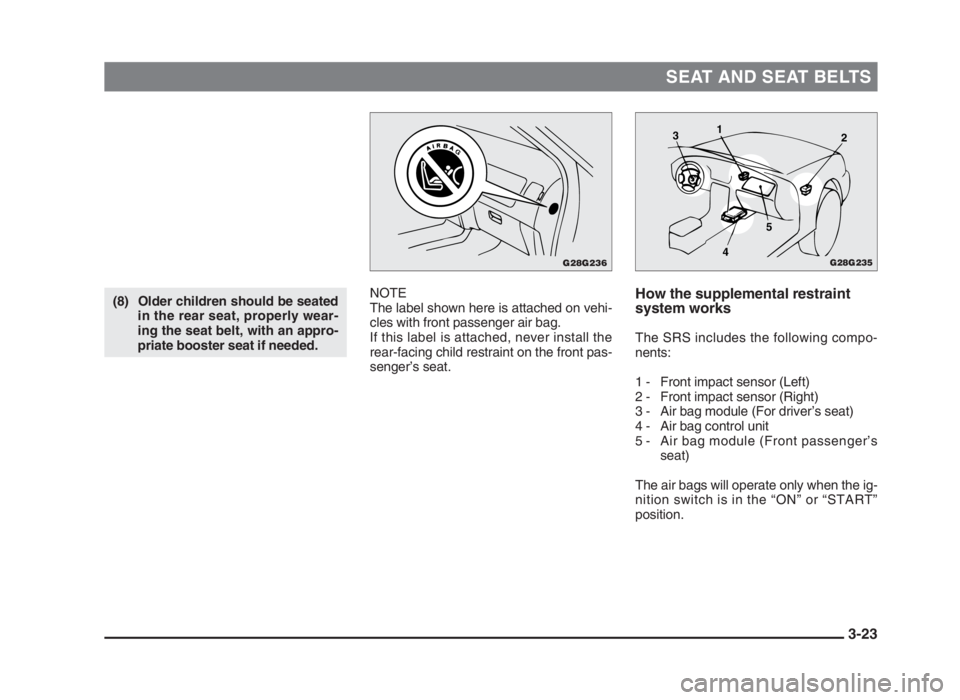
SEAT AND SEAT BELTS
3-23
(8) Older children should be seated
in the rear seat, properly wear-
ing the seat belt, with an appro-
priate booster seat if needed.How the supplemental restraint
system works
The SRS includes the following compo-
nents:
1 - Front impact sensor (Left)
2 - Front impact sensor (Right)
3 - Air bag module (For driver’s seat)
4 - Air bag control unit
5 - Air bag module (Front passenger’s
seat)
The air bags will operate only when the ig-
nition switch is in the “ON” or “START”
position. NOTE
The label shown here is attached on vehi-
cles with front passenger air bag.
If this label is attached, never install the
rear-facing child restraint on the front pas-
senger’s seat.
G28G236G28G235
1
3
2
5
4
03engL2_240082_4 22-01-2004 13:01 Page 3-23
Page 56 of 264
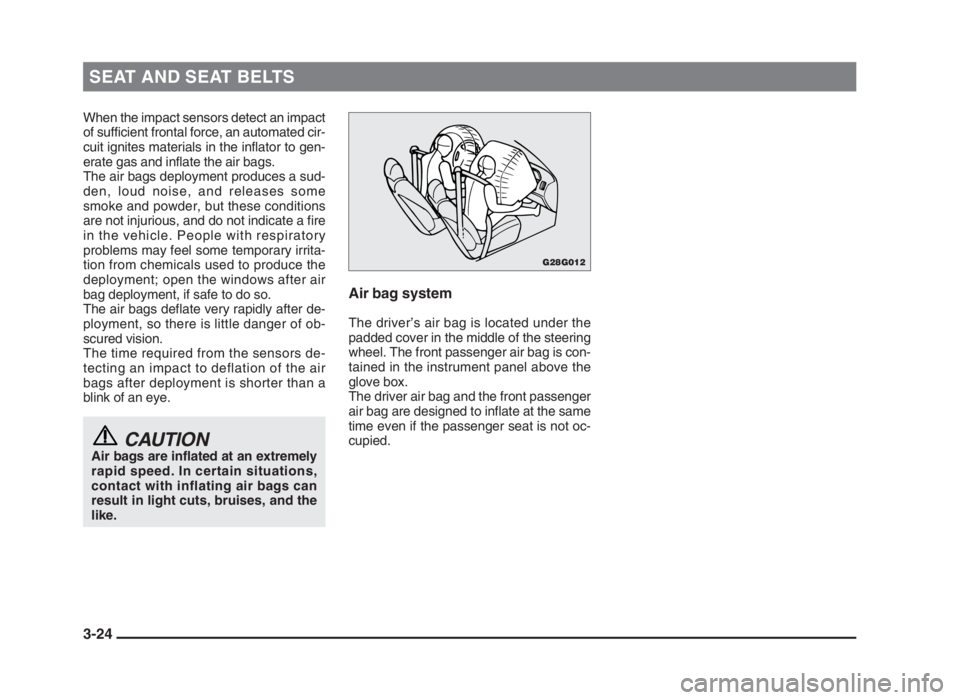
SEAT AND SEAT BELTS
3-24
When the impact sensors detect an impact
of sufficient frontal force, an automated cir-
cuit ignites materials in the inflator to gen-
erate gas and inflate the air bags.
The air bags deployment produces a sud-
den, loud noise, and releases some
smoke and powder, but these conditions
are not injurious, and do not indicate a fire
in the vehicle. People with respiratory
problems may feel some temporary irrita-
tion from chemicals used to produce the
deployment; open the windows after air
bag deployment, if safe to do so.
The air bags deflate very rapidly after de-
ployment, so there is little danger of ob-
scured vision.
The time required from the sensors de-
tecting an impact to deflation of the air
bags after deployment is shorter than a
blink of an eye.
CAUTIONAir bags are inflated at an extremely
rapid speed. In certain situations,
contact with inflating air bags can
result in light cuts, bruises, and the
like.
Air bag system
The driver’s air bag is located under the
padded cover in the middle of the steering
wheel. The front passenger air bag is con-
tained in the instrument panel above the
glove box.
The driver air bag and the front passenger
air bag are designed to inflate at the same
time even if the passenger seat is not oc-
cupied.
G28G012
03engL2_240082_4 22-01-2004 13:01 Page 3-24
Page 57 of 264
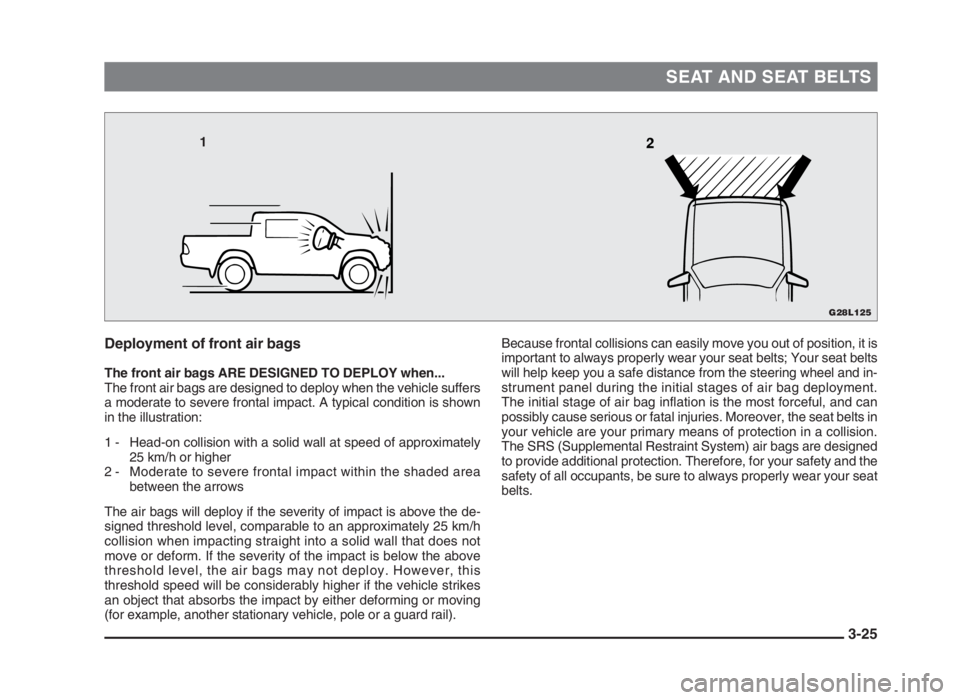
SEAT AND SEAT BELTS
3-25 Deployment of front air bags
The front air bags ARE DESIGNED TO DEPLOY when...
The front air bags are designed to deploy when the vehicle suffers
a moderate to severe frontal impact. A typical condition is shown
in the illustration:
1 - Head-on collision with a solid wall at speed of approximately
25 km/h or higher
2 - Moderate to severe frontal impact within the shaded area
between the arrows
The air bags will deploy if the severity of impact is above the de-
signed threshold level, comparable to an approximately 25 km/h
collision when impacting straight into a solid wall that does not
move or deform. If the severity of the impact is below the above
threshold level, the air bags may not deploy. However, this
threshold speed will be considerably higher if the vehicle strikes
an object that absorbs the impact by either deforming or moving
(for example, another stationary vehicle, pole or a guard rail).Because frontal collisions can easily move you out of position, it is
important to always properly wear your seat belts; Your seat belts
will help keep you a safe distance from the steering wheel and in-
strument panel during the initial stages of air bag deployment.
The initial stage of air bag inflation is the most forceful, and can
possibly cause serious or fatal injuries. Moreover, the seat belts in
your vehicle are your primary means of protection in a collision.
The SRS (Supplemental Restraint System) air bags are designed
to provide additional protection. Therefore, for your safety and the
safety of all occupants, be sure to always properly wear your seat
belts.
1
G28L125
03engL2_240082_4 22-01-2004 13:01 Page 3-25
Page 58 of 264
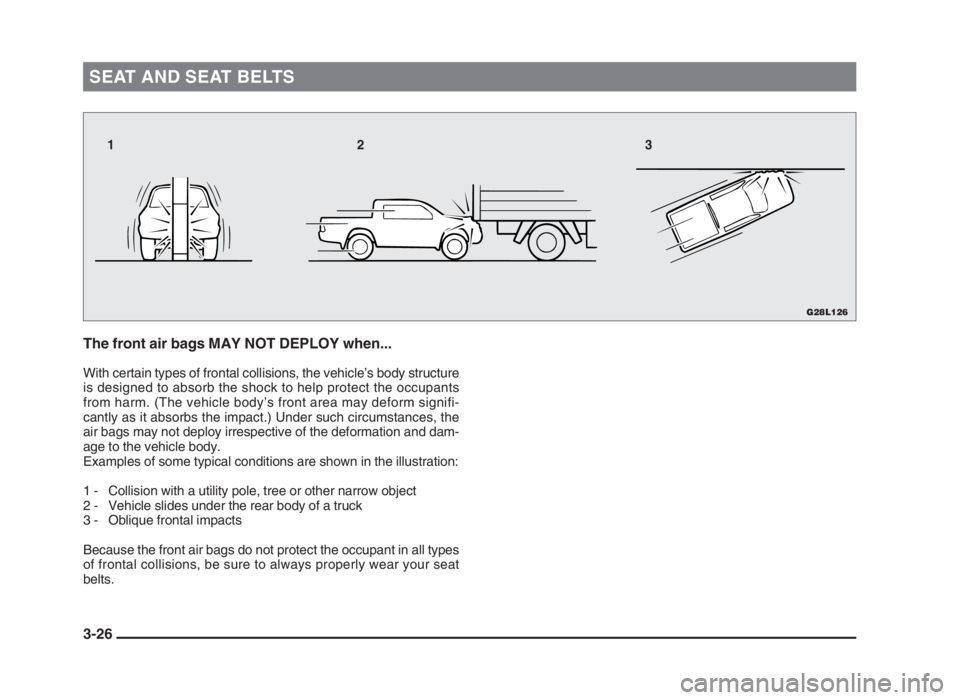
SEAT AND SEAT BELTS
3-26 The front air bags MAY NOT DEPLOY when...
With certain types of frontal collisions, the vehicle’s body structure
is designed to absorb the shock to help protect the occupants
from harm. (The vehicle body’s front area may deform signifi-
cantly as it absorbs the impact.) Under such circumstances, the
air bags may not deploy irrespective of the deformation and dam-
age to the vehicle body.
Examples of some typical conditions are shown in the illustration:
1 - Collision with a utility pole, tree or other narrow object
2 - Vehicle slides under the rear body of a truck
3 - Oblique frontal impacts
Because the front air bags do not protect the occupant in all types
of frontal collisions, be sure to always properly wear your seat
belts.
G28L126
12 3
03engL2_240082_4 22-01-2004 13:01 Page 3-26
Page 59 of 264
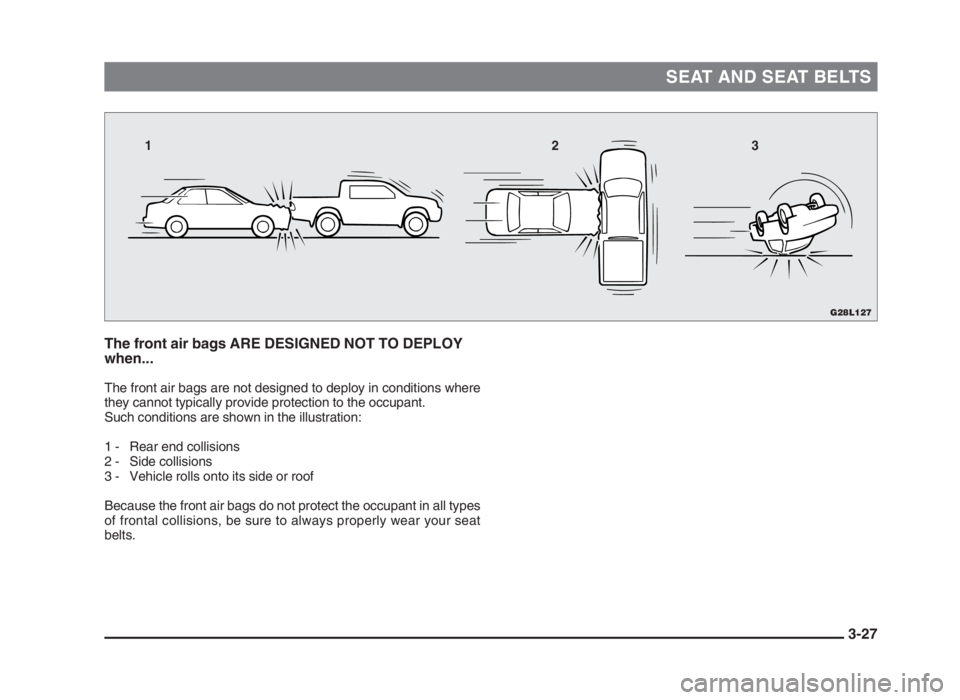
SEAT AND SEAT BELTS
3-27 The front air bags ARE DESIGNED NOT TO DEPLOY
when...
The front air bags are not designed to deploy in conditions where
they cannot typically provide protection to the occupant.
Such conditions are shown in the illustration:
1 - Rear end collisions
2 - Side collisions
3 - Vehicle rolls onto its side or roof
Because the front air bags do not protect the occupant in all types
of frontal collisions, be sure to always properly wear your seat
belts.
G28L127
123
03engL2_240082_4 22-01-2004 13:01 Page 3-27
Page 60 of 264

SEAT AND SEAT BELTS
3-28 The front air bags MAY DEPLOY when...
The front air bags may deploy if the bottom of the vehicle suffers a
moderate to severe impact (undercarriage damage).
Examples of some typical conditions are shown in the illustration:
1 - Collision with an elevated median/island or curb
2 - Vehicle travels over a deep hole/pothole
3 - Vehicle drives down a steep slope and hits the ground
Because the front air bags may deploy in certain types of unex-
pected impacts as shown in the illustrations that can easily move
you out of position, it is important to always properly wear your
seat belts. Your seat belts will help keep you a safe distance from
the steering wheel and instrument panel during the initial stages
of air bag deployment. The initial stage of air bag inflation is the
most forceful and can possibly cause serious or fatal injuries if
you contact it at this stage.
G28L128
123
03engL2_240082_4 22-01-2004 13:01 Page 3-28